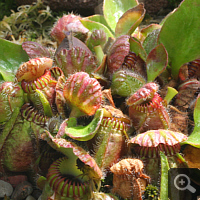Albany Pitcher Plant (Cephalotus)
Overview
The Albany Pitcher Plant is development-biological relative isolated. This monotypic genus is the only member of the Oxalidales-order. The plant is isolated to be found within a small area in the extreme south-southwest of Australia around Albany on a very sandy, all-year moist peat.
The perennial and restant plant possesses a repent rhizome, from which partly from several vegetation centres the leafes or pitchers arise. The Albany Pitcher Plant is only during the warm half of the year carnivorous. Then it produces circa 2 – 3 cm long, pediculated pitchers, which slight oblique rest on the ground. Above the pitcher opening is a lid, which on the one hand should protect the digestive juice against dilution by rainfalls. In the case of a very dry and hot weather the lid declines on the opening and prevents thus an evaporation of the digestive juice. The trap opening is surrounded by a peristome, at the front of the pitcher three pilose wing ribs guide from the ground to the peristome. In the case of intensive direct sunlight the pitcher changes colour into intensive puce.
During the winter the Albany Pitcher Plant abandons its carnivory. Instead of pitchers now are normal, obovate to spatulate leaves produced.
Trap mechanism
The principle trap mechanism was already detailed described on the previous site. Along the wing ribs are mainly ants, to a minor degree also other crawling insects, which are attracted by sweet secretions, guided towards the peristome. Below of the peristome the interior wall of the pitcher is very smooth, so that the prey fall into the digestive liquid, which contains several different enzymes. The Albany Pitcher Plant does not show an interior hairiness of the trap.
Culture and propagation
The culture of the Albany Pitcher Plant is a little bit more difficult and therefore for the beginnner unsuitable. The Albany Pitcher Plant prefers a very sandy soil, so that a mixture of peat with quartz sand in a ratio of 1:1 to 1:2 is chosen. I cultivate my Albany Pitcher Plant in a large clay pot, which I embed in my raised bog bed during the summer. Apart from that is also a watering in a slight permanent ebb and flood irrigation system possible. You should wait before refilling, until the water is almost completely consumed. The Albany Pitcher Plant is not hardy, so that it must be brought indoors before the first frost. There it prefers a light and cool location. The Albany Pitcher Plant reacts sensitive on watering from above. Is water in the vegetation centres left, so here it can quickly rot.
A generative propagation is less efficient. The Albany Pitcher Plant produces only sparsely seeds, which even germinate for a short time. A sight more efficient is vegetative propagation, which can take place in two ways. Great specimens show several vegetation centres, which can be divided. In the case of separation you should pay attention to the following aspects. Use only a very clean, sharp knife. A previous disinfection for example with alcohol is important. Divide the rhizome in an adequate distance to the next vegetation centres. Each centre must remain enough roots. Cut through the rhizome carefully. Under no circumstances this should be bruised or fringed. Therefore use only a sharp knife, so that you have a smooth cut surface at the end. Let the cut surface dry off at the air, before you prick in both parts again. A previous application of activated coal on the cut surface is not wrong. Thus you reduce the danger to an infection of the cut surfaces for example with mould fungi.
Besides a propagation by division is also the propagation method of cutting available. Thereto both leaves and pitchers can be used. Both have to cut direct at the rhizome. Most effectively this should be conducted by carefully plucking. The white base of the leaf or of the pitcher is afterwards given circa 1 cm deep in sandy peat. Under a slight permanent ebb and flood irrigation system and a high humidity you now have to prove patience. In any case you should withstand the temptation to look for after a while, because you will almost inevitably tear off thereby the in the meantime evolving offshoot within the soil. It can take many weeks, before the first leaves appear out of earth. The attempt is only then failed, if the leaf or the pitcher is dead. Even if the leaf turns gradually yellow after weeks, a small plant can still appear short time later.

